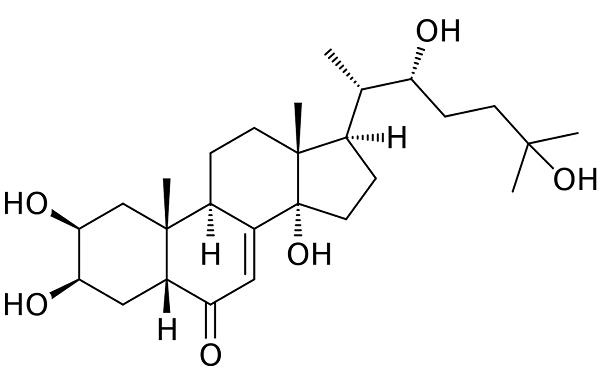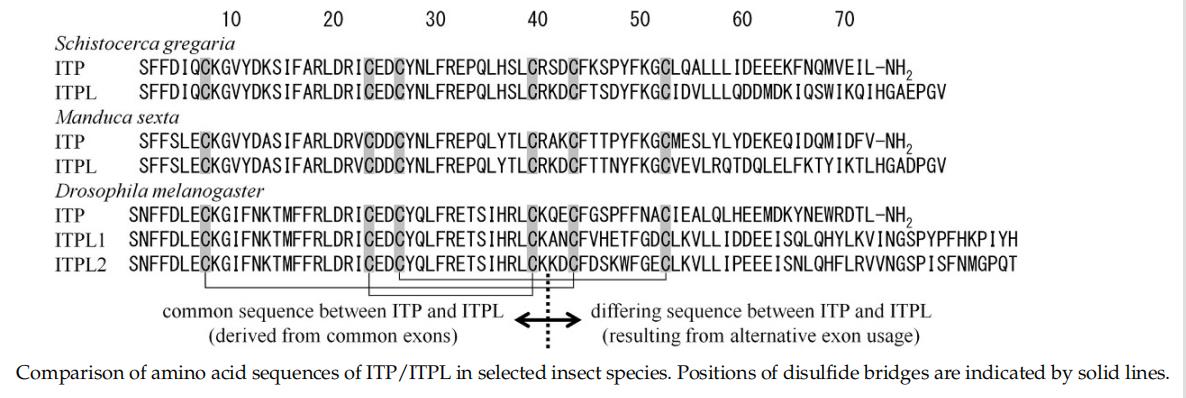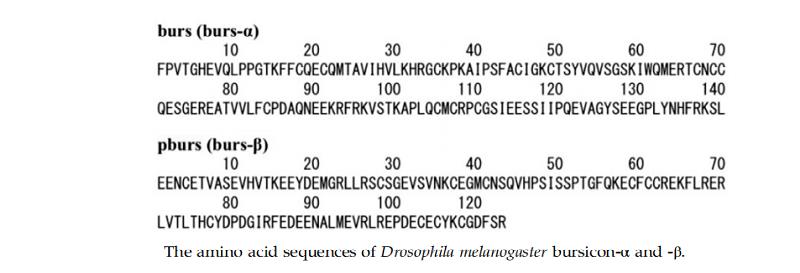Biological functions and Structure of prothoracicotropic hormone
The prothoracicotropic hormone (PTTH) was first described in 1922 as a hormonal factor that triggers insect pupation.A partial structure of PTTH of the silkworm Bombyx mori was identified in 1987 followed by the cloning of the Bombyx PTTH gene in 1990.
Structure
The mature PTTH forms a homodimer linked by an interchain disulfide bond while a cystine knot motif composed of three intrachain disulfide bridges is likely formed within each chain. Silkworm PTTH has been reported to have a carbohydrate chain at Asn although its recombinant protein lacking the sugar chain also exhibits activity to induce adult development.Although the seven Cys residues that form inter- and intrachain disulfide bonds are highly conserved among PTTHs of various insect species, their primary structures are much less conserved. For example, the sequence of the silkworm PTTH shares 40%–60% identity with those of other lepidopteran PTTHs, but only retains~20% identity with that of the fruit fly, Drosophila melanogaster. In addition, most of the lepidopteran PTTHs have potential N-glycosylation sites while that of D. melanogaster does not.

Gene, mRNA, and precursor The PTTH mRNA encodes the prepro-PTTH protein of ~200 aa residues, including the N-terminal signal peptide. The mature PTTH is located on the C-terminal end of the prohormone.
Regulation of synthesis and release
The silkworm PTTH produced in the brain neurosecretory cells is transported through their axons and stored in the corpora allata. In response to environmental stimuli such as the light-dark cycle, PTTH is released from the corpora allata into the hemolymph and the transient increase of its concentration in the hemolymph stimulates ecdysone biosynthesis in the prothoracic glands.In contrast, Drosophila PTTH is secreted in proximity of the prothoracic gland cells within the ring gland from axon terminals that directly contact the gland.Upstream neurons that innervate the PTTH-producing neurons and regulate their activity are beginning to be identified in D. melanogaster.
Biological functions
Target cells/tissues and functions The primary function of PTTH is to promote the biosynthesis of the molting hormone ecdysone in the prothoracic glands in response to environmental stimuli. This is best demonstrated by its regulatory role in pupal diapause; for example, in the cabbage army moth Mamestra brassicae, the hemolymph PTTH titer is reduced during the diapause period, but it is released into the hemolymph to promote ecdysone biosynthesis when the environmental condition allows for adult development.16 Torso is indeed highly expressed in the prothoracic glands to mediate this ecdysteroidogenic function of PTTH, but it is also expressed in light-sensing peripheral neurons to promote light-avoidance behavior during the wandering stage before pupation.
Phenotype of gene-modified animals
PTTH mutant insects have been reported in B. mori and D. melanogaster.In both cases, loss-of-function phenotypes suggest that PTTH is important for the upregulation of ecdysteroidogenesis to maintain a normal developmental schedule, but it is not essential for ecdysone biosynthesis per se. This is consistent with previous findings suggesting that PTTH is a regulator of developmental timing and related behaviors in response to environmental stimuli, but not an essential component of insect development.


